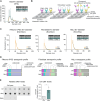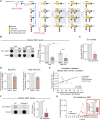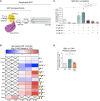Gangliosides modulate the secretion of extracellular vesicles and their misfolded protein cargo
- PMID: 40961208
- PMCID: PMC12442881
- DOI: 10.1126/sciadv.ady5212
Gangliosides modulate the secretion of extracellular vesicles and their misfolded protein cargo
Abstract
Gangliosides are glycosphingolipids with important roles in cell signaling and neuroprotection. While present on extracellular vesicles (EVs)-key mediators of intercellular communication-their role in EV biogenesis remains unclear. Here, we identify gangliosides as key modulators of EV biogenesis, with the specific composition of their glycan headgroup and the presence or absence of sialic acid and N-acetyl-d-galactosamine residues dictating whether they promote or inhibit EV biogenesis. GM1 and other complex gangliosides enhance EV secretion, while disruption of ganglioside synthesis impairs it. GM1 supplementation restores EV secretion in Huntington's disease (HD) fibroblasts and cell models with ganglioside deficiency, including models of neurodegenerative diseases caused by a genetic block of ganglioside synthesis. Notably, GM1 enhances EV-mediated secretion of pathogenic misfolded proteins, including mutant huntingtin (mHTT), α-synuclein, and tau, reducing intracellular burden and providing mechanistic insight into the mHTT-lowering effects of GM1 in HD models. Our findings shed light on the neuroprotective roles of gangliosides and their therapeutic potential in misfolded protein disorders.
Figures








References
-
- van Niel G., D'Angelo G., Raposo G., Shedding light on the cell biology of extracellular vesicles. Nat. Rev. Mol. Cell Biol. 19, 213–228 (2018). - PubMed
-
- Takeuchi T., Pathogenic and protective roles of extracellular vesicles in neurodegenerative diseases. J. Biochem. 169, 181–186 (2021). - PubMed
-
- Liang W., Sagar S., Ravindran R., Najor R. H., Quiles J. M., Chi L., Diao R. Y., Woodall B. P., Leon L. J., Zumaya E., Duran J., Cauvi D. M., De Maio A., Adler E. D., Gustafsson A. B., Mitochondria are secreted in extracellular vesicles when lysosomal function is impaired. Nat. Commun. 14, 5031 (2023). - PMC - PubMed
MeSH terms
Substances
LinkOut - more resources
Full Text Sources

